SUBARU BRZ 2023 Owners Manual
Manufacturer: SUBARU, Model Year: 2023, Model line: BRZ, Model: SUBARU BRZ 2023Pages: 432, PDF Size: 16.56 MB
Page 251 of 432
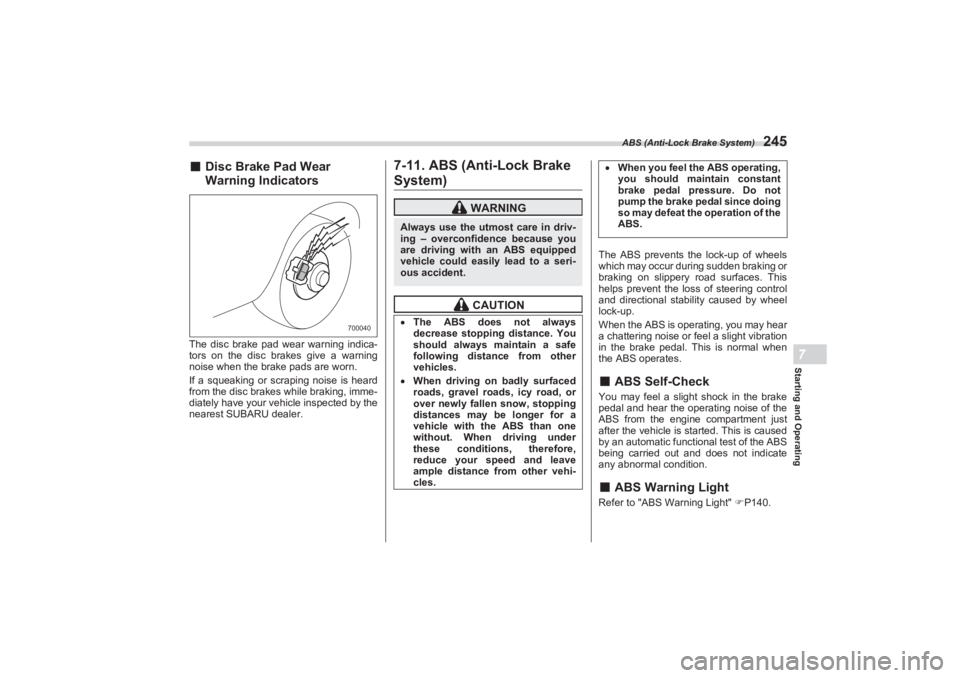
ABS (Anti-Lock Brake System)
245
Starting and Operating7
■Disc Brake Pad Wear
Wa rning IndicatorsThe disc brake pad wear warning indica-
tors on the disc brakes give a warning
noise when the brake pads are worn.
If a squeaking or scraping noise is heard
from the disc brakes while braking, imme-
diately have your vehicle inspected by the
nearest SUBARU dealer.
7-11. ABS (Anti-Lock BrakeSystem)
The ABS prevents the lock-up of wheels
which may occur during sudden braking or
braking on slippery road surfaces. This
helps prevent the loss of steering control
and directional stability caused by wheel
lock-up.
When the ABS is operating, you may hear
a chattering noise or f eel a slight vibration
in the brake pedal. This is normal when
the ABS operates.■ ABS Self-CheckYou may feel a slight shock in the brake
pedal and hear the operating noise of the
ABS from the engine compartment just
after the vehicle is started. This is caused
by an automatic functional test of the ABS
being carried out and does not indicate
any abnormal condition.■ ABS Warning LightRefer to "ABS Warning Light" P140.
700040
WARNING
Always use the utmost care in driv-
ing – overconfidence because you
are driving with an ABS equipped
vehicle could easily lead to a seri-
ous accident.
CAUTION
The ABS does not always
decrease stopping distance. You
should always maintain a safe
following distance from other
vehicles. When driving on badly surfaced
roads, gravel roads, icy road, or
over newly fallen snow, stopping
distances may be longer for a
vehicle with the ABS than one
without. When driving under
these conditions, therefore,
reduce your speed and leave
ample distance from other vehi-
cles.
When you feel the ABS operating,
you should maintain constant
brake pedal pressure. Do not
pump the brake pedal since doing
so may defeat the operation of the
ABS.
BRZ_U.book 245 ページ 2022年3月29日 火曜日 午後3時59分
Page 252 of 432
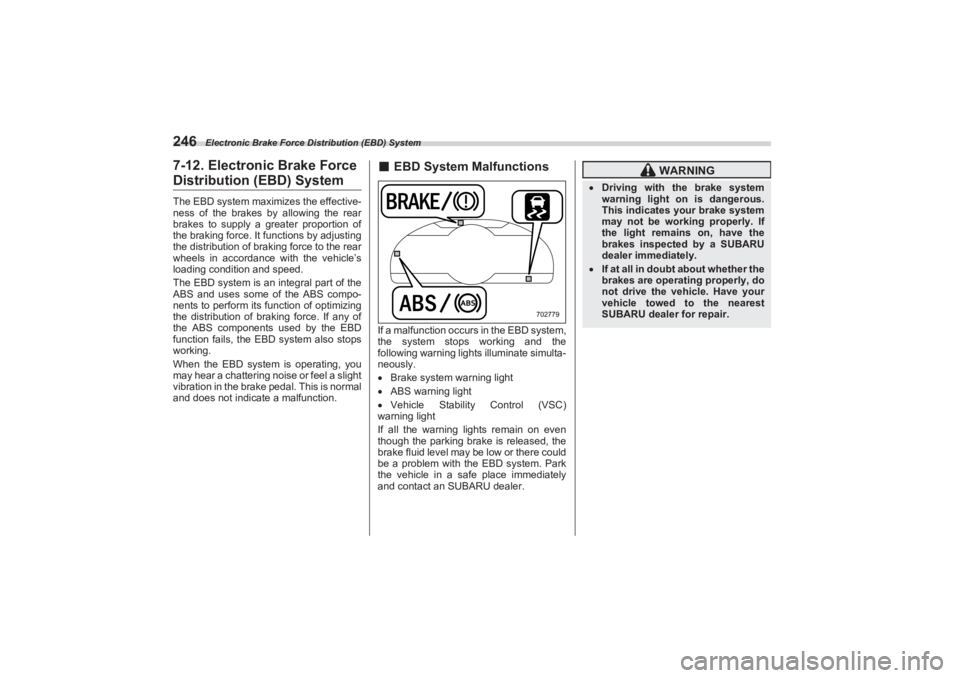
Electronic Brake Force Distribution (EBD) System
2467-12. Electronic Brake Force Distribution (EBD) SystemThe EBD system maximizes the effective-
ness of the brakes by allowing the rear
brakes to supply a greater proportion of
the braking force. It functions by adjusting
the distribution of braking force to the rear
wheels in accordance with the vehicle’s
loading condition and speed.
The EBD system is an in tegral part of the
ABS and uses some of the ABS compo-
nents to perform its function of optimizing
the distribution of braking force. If any of
the ABS components used by the EBD
function fails, the EBD system also stops
working.
When the EBD system is operating, you
may hear a chattering noise or feel a slight
vibration in the brake pedal. This is normal
and does not indicate a malfunction.
■ EBD System MalfunctionsIf a malfunction occurs in the EBD system,
the system stops working and the
following warning lights illuminate simulta-
neously.
Brake system warning light
ABS warning light
Vehicle Stability Control (VSC)
warning light
If all the warning lights remain on even
though the parking brake is released, the
brake fluid level may be low or there could
be a problem with the EBD system. Park
the vehicle in a safe place immediately
and contact an SUBARU dealer.
702779
WARNING
Driving with the brake system
warning light on is dangerous.
This indicates your brake system
may not be working properly. If
the light remains on, have the
brakes inspected by a SUBARU
dealer immediately. If at all in doubt about whether the
brakes are operating properly, do
not drive the vehicle. Have your
vehicle towed to the nearest
SUBARU dealer for repair.
BRZ_U.book 246 ページ 2022年3月29日 火曜日 午後3時59分
Page 253 of 432
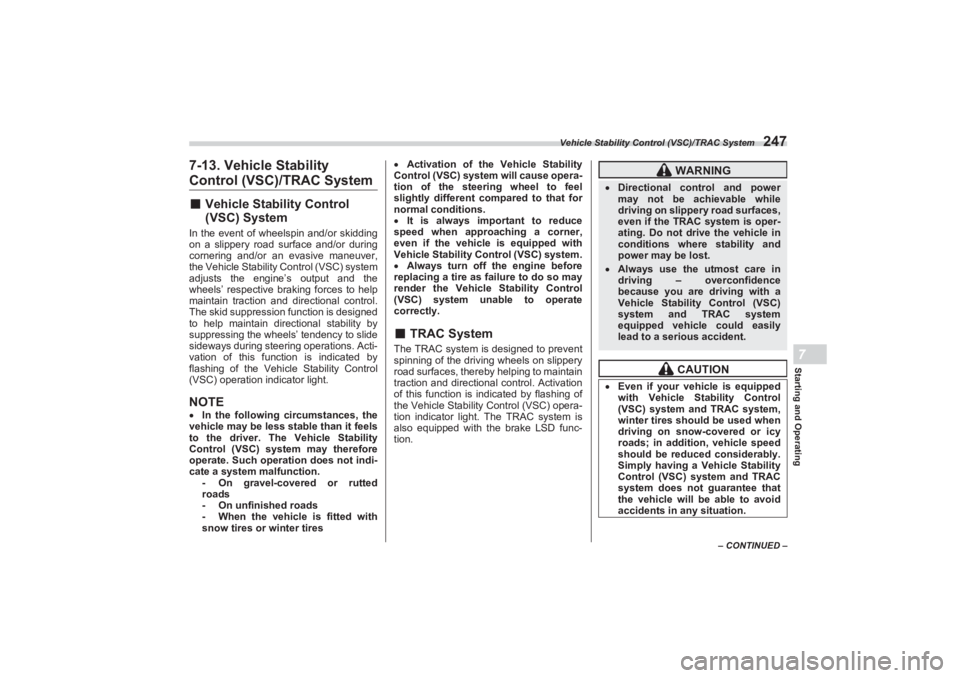
Vehicle Stability Control (VSC)/TRAC System
247
Starting and Operating7
– CONTINUED –
7-13. Vehicle Stability Control (VSC)/TRAC System■Vehicle Stability Control
(VSC) SystemIn the event of wheelspin and/or skidding
on a slippery road surface and/or during
cornering and/or an evasive maneuver,
the Vehicle Stability Control (VSC) system
adjusts the engine’s output and the
wheels’ respective braking forces to help
maintain traction and directional control.
The skid suppression function is designed
to help maintain directional stability by
suppressing the wheels’ tendency to slide
sideways during steering operations. Acti-
vation of this function is indicated by
flashing of the Vehicle Stability Control
(VSC) operation indicator light.NOTE In the following circumstances, the
vehicle may be less stable than it feels
to the driver. The Vehicle Stability
Control (VSC) system may therefore
operate. Such operation does not indi-
cate a system malfunction. - On gravel-covered or rutted
roads
- On unfinished roads
- When the vehicle is fitted with
snow tires or winter tires
Activation of the Vehicle Stability
Control (VSC) system will cause opera-
tion of the steering wheel to feel
slightly different compared to that for
normal conditions.
It is always important to reduce
speed when approaching a corner,
even if the vehicle is equipped with
Vehicle Stability Control (VSC) system.
Always turn off the engine before
replacing a tire as failure to do so may
render the Vehicle Stability Control
(VSC) system unable to operate
correctly.
■ TRAC SystemThe TRAC system is designed to prevent
spinning of the driving wheels on slippery
road surfaces, thereby helping to maintain
traction and directional control. Activation
of this function is indicated by flashing of
the Vehicle Stability Control (VSC) opera-
tion indicator light. The TRAC system is
also equipped with the brake LSD func-
tion.
WARNING
Directional control and power
may not be achievable while
driving on slippery road surfaces,
even if the TRAC system is oper-
ating. Do not drive the vehicle in
conditions where stability and
power may be lost. Always use the utmost care in
driving – overconfidence
because you are driving with a
Vehicle Stability Control (VSC)
system and TRAC system
equipped vehicle could easily
lead to a serious accident.
CAUTION
Even if your vehicle is equipped
with Vehicle Stability Control
(VSC) system and TRAC system,
winter tires should be used when
driving on snow-covered or icy
roads; in addition, vehicle speed
should be reduced considerably.
Simply having a Vehicle Stability
Control (VSC) system and TRAC
system does not guarantee that
the vehicle will be able to avoid
accidents in any situation.
BRZ_U.book 247 ページ 2022年3月29日 火曜日 午後3時59分
Page 254 of 432
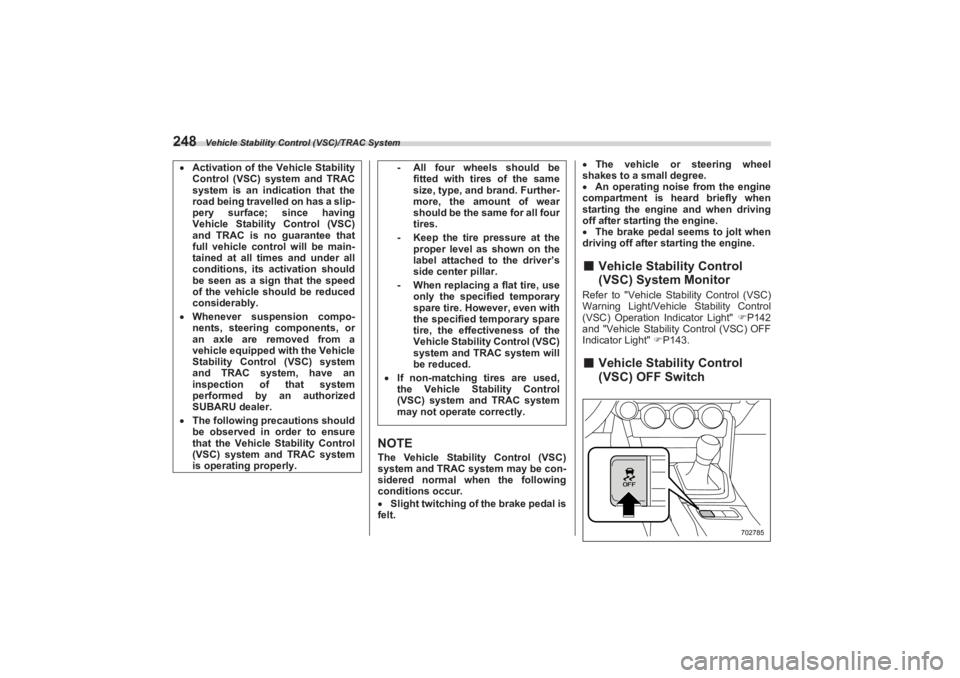
Vehicle Stability Control (VSC)/TRAC System
248
NOTEThe Vehicle Stability Control (VSC)
system and TRAC system may be con-
sidered normal when the following
conditions occur.
Slight twitching of the brake pedal is
felt.
The vehicle or steering wheel
shakes to a small degree.
An operating noise from the engine
compartment is heard briefly when
starting the engine and when driving
off after starti ng the engine.
The brake pedal seems to jolt when
driving off after st arting the engine.
■Vehicle Stability Control
(VSC) System MonitorRefer to "Vehicle Stability Control (VSC)
Warning Light/Vehicle Stability Control
(VSC) Operation Indicator Light" P142
and "Vehicle Stability Control (VSC) OFF
Indicator Light" P143.■ Vehicle Stability Control
(VSC) OFF Switch
Activation of the Vehicle Stability
Control (VSC) system and TRAC
system is an indication that the
road being travelled on has a slip-
pery surface; since having
Vehicle Stability Control (VSC)
and TRAC is no guarantee that
full vehicle control will be main-
tained at all times and under all
conditions, its activation should
be seen as a sign that the speed
of the vehicle should be reduced
considerably. Whenever suspension compo-
nents, steering components, or
an axle are removed from a
vehicle equipped with the Vehicle
Stability Control (VSC) system
and TRAC system, have an
inspection of that system
performed by an authorized
SUBARU dealer. The following precautions should
be observed in order to ensure
that the Vehicle Stability Control
(VSC) system and TRAC system
is operating properly.
- All four wheels should be
fitted with tires of the same
size, type, and brand. Further-
more, the amount of wear
should be the same for all four
tires.- Keep the tire pressure at the
proper level as shown on the
label attached to the driver’s
side center pillar.- When replacing a flat tire, use
only the specified temporary
spare tire. However, even with
the specified temporary spare
tire, the effectiveness of the
Vehicle Stability Control (VSC)
system and TRAC system will
be reduced.
If non-matching tires are used,
the Vehicle Stability Control
(VSC) system and TRAC system
may not operate correctly.
702785
BRZ_U.book 248 ページ 2022年3月29日 火曜日 午後3時59分
Page 255 of 432
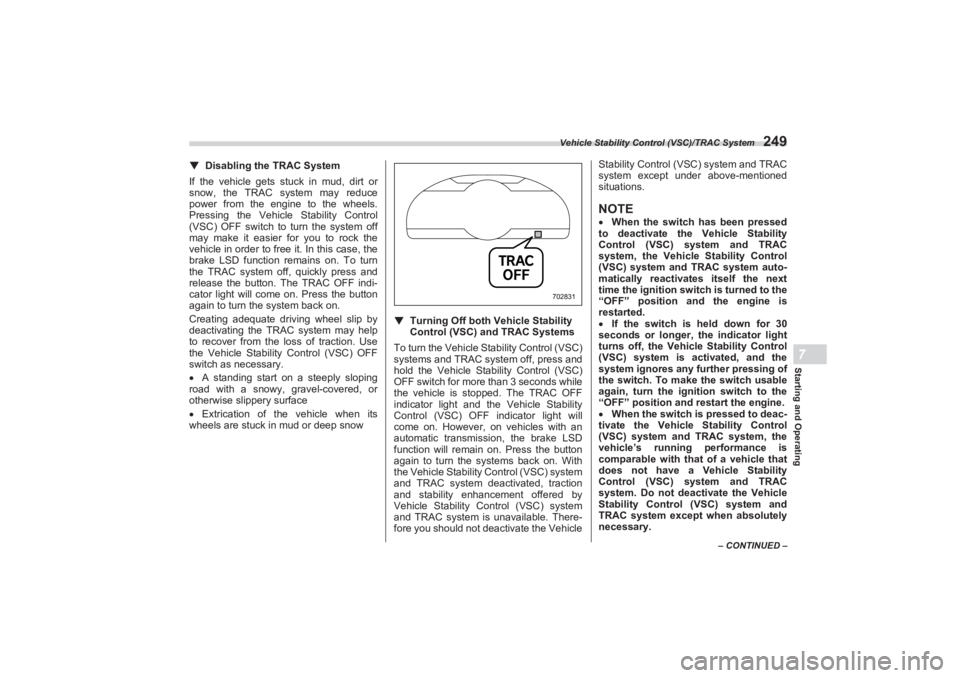
Vehicle Stability Control (VSC)/TRAC System
249
Starting and Operating7
– CONTINUED –
▼Disabling the TRAC System
If the vehicle gets stuck in mud, dirt or
snow, the TRAC system may reduce
power from the engine to the wheels.
Pressing the Vehicle Stability Control
(VSC) OFF switch to turn the system off
may make it easier for you to rock the
vehicle in order to free it. In this case, the
brake LSD function remains on. To turn
the TRAC system off, quickly press and
release the button. The TRAC OFF indi-
cator light will come on. Press the button
again to turn the system back on.
Creating adequate driving wheel slip by
deactivating the TRAC system may help
to recover from the loss of traction. Use
the Vehicle Stability Control (VSC) OFF
switch as necessary.
A standing start on a steeply sloping
road with a snowy, gravel-covered, or
otherwise slippery surface
Extrication of the vehicle when its
wheels are stuck in mud or deep snow ▼
Turning Off both Vehicle Stability
Control (VSC) and TRAC Systems
To turn the Vehicle Stability Control (VSC)
systems and TRAC system off, press and
hold the Vehicle Stability Control (VSC)
OFF switch for more than 3 seconds while
the vehicle is stopped. The TRAC OFF
indicator light and the Vehicle Stability
Control (VSC) OFF indicator light will
come on. However, on vehicles with an
automatic transmissi on, the brake LSD
function will remain on. Press the button
again to turn the systems back on. With
the Vehicle Stability Control (VSC) system
and TRAC system deactivated, traction
and stability enhancement offered by
Vehicle Stability Control (VSC) system
and TRAC system is unavailable. There-
fore you should not deactivate the Vehicle Stability Control (VSC) system and TRAC
system except under above-mentioned
situations.
NOTE When the switch has been pressed
to deactivate the Vehicle Stability
Control (VSC) system and TRAC
system, the Vehicle Stability Control
(VSC) system and TRAC system auto-
matically reactivates itself the next
time the ignition swit ch is turned to the
“OFF” position and the engine is
restarted.
If the switch is held down for 30
seconds or longer, the indicator light
turns off, the Vehicle Stability Control
(VSC) system is activated, and the
system ignores any further pressing of
the switch. To make the switch usable
again, turn the ignition switch to the
“OFF” position and restart the engine.
When the switch is pressed to deac-
tivate the Vehicle Stability Control
(VSC) system and TRAC system, the
vehicle’s running performance is
comparable with that of a vehicle that
does not have a Vehicle Stability
Control (VSC) system and TRAC
system. Do not deac tivate the Vehicle
Stability Control (VSC) system and
TRAC system except when absolutely
necessary.
702831
BRZ_U.book 249 ページ 2022年3月29日 火曜日 午後3時59分
Page 256 of 432

TRACK Mode
250Even when the TRAC system is
deactivated, components of the brake
control system may still activate. When
the brake control system is activated,
the Vehicle Stability Control (VSC)
operation indicator light flashes.
7-14. TRACK Mode■ TRACK ModeYour vehicle is equipped with two types of
control modes to accommodate various
driving preferences. The control modes
can be selected with the TRACK switch.
Normal mode allows secure and smooth
normal driving. When the switch is
pressed and held for 1 second or more,
TRACK mode is activated. Control char-
acteristics such as the Vehicle Stability
Control (VSC) and TRAC are adjusted to
afford maneuverability closer to what a
driver may desire, while a sense of secu-
rity is retained.
▼ TRACK mode/Normal mode
The TRACK indicator and Vehicle Stability
Control (VSC) OFF indicator come on
when in TRACK mode.
To change back to normal mode while in
TRACK mode, press Vehicle Stability
Control (VSC) OFF switch or the TRACK
switch.
702840
BRZ_U.book 250 ページ 2022年3月29日 火曜日 午後3時59分
Page 257 of 432
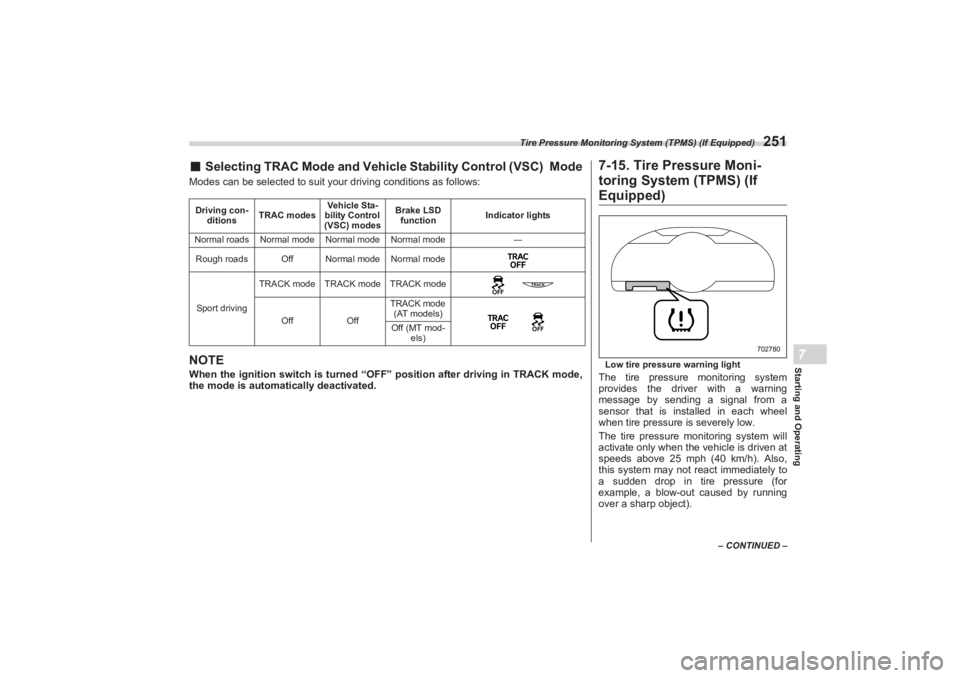
Tire Pressure Monitoring System (TPMS) (If Equipped)
251
– CONTINUED –
Starting and Operating7
■Selecting TRAC Mode and Vehicle Stability Control (VSC) ModeModes can be selected to suit your driving conditions as follows:NOTEWhen the ignition switch is turned “OFF” position af ter driving in TRACK mode,
the mode is automa tically deactivated.Driving con-
ditions TRAC modes Vehicle Sta-
bility Control
(VSC) modes Brake LSD
function Indicator lights
Normal roads Normal mode Normal mode Normal mode ―
Rough roads Off Normal mode Normal mode
Sport driving TRACK mode TRACK mode TRACK mode
Off OffTRACK mode
(AT models)
Off (MT mod-
els)
7-15. Tire Pressure Moni -
toring System (TPMS) (If Equipped)Low tire pressure warning lightThe tire pressure monitoring system
provides the driver with a warning
message by sending a signal from a
sensor that is installed in each wheel
when tire pressure is severely low.
The tire pressure monitoring system will
activate only when the vehicle is driven at
speeds above 25 mph (40 km/h). Also,
this system may not react immediately to
a sudden drop in tire pressure (for
example, a blow-out caused by running
over a sharp object).
702780
BRZ_U.book 251 ページ 2022年3月29日 火曜日 午後3時59分
Page 258 of 432
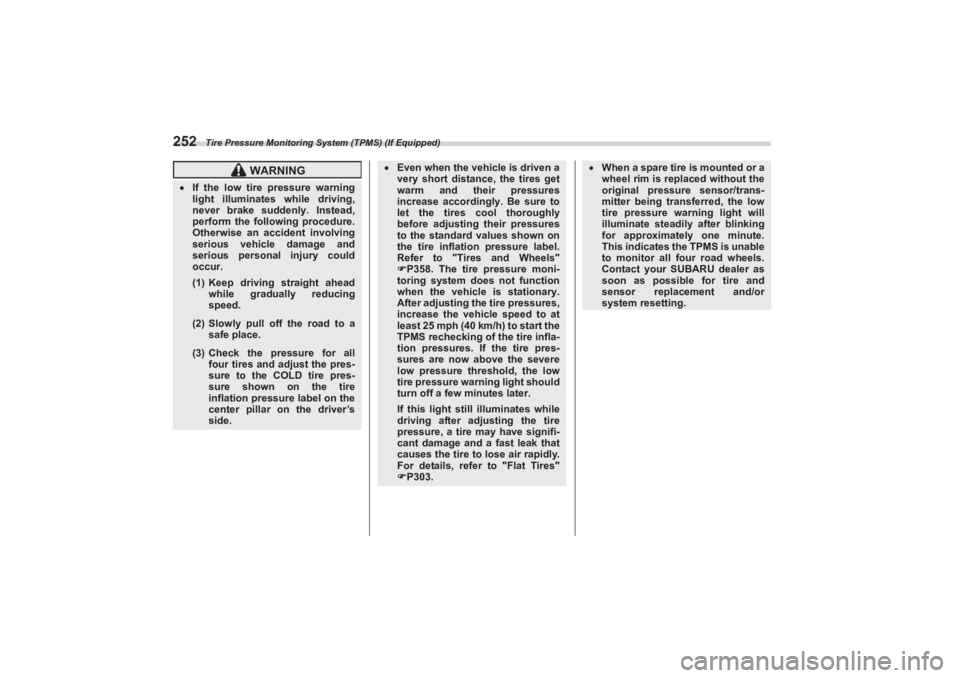
Tire Pressure Monitoring System (TPMS) (If Equipped)
252
WARNING
If the low tire pressure warning
light illuminates while driving,
never brake suddenly. Instead,
perform the following procedure.
Otherwise an accident involving
serious vehicle damage and
serious personal injury could
occur.
(1) Keep driving straight ahead
while gradually reducing
speed.(2) Slowly pull off the road to a
safe place.(3) Check the pressure for all
four tires and adjust the pres-
sure to the COLD tire pres-
sure shown on the tire
inflation pressure label on the
center pillar on the driver’s
side.
Even when the vehicle is driven a
very short distance, the tires get
warm and their pressures
increase accordingly. Be sure to
let the tires cool thoroughly
before adjusting their pressures
to the standard values shown on
the tire inflatio n pressure label.
Refer to "Tires and Wheels"
P358. The tire pressure moni-
toring system does not function
when the vehicle is stationary.
After adjusting the tire pressures,
increase the vehicle speed to at
least 25 mph (40 km/h) to start the
TPMS rechecking of the tire infla-
tion pressures. If the tire pres-
sures are now above the severe
low pressure threshold, the low
tire pressure warning light should
turn off a few minutes later.
If this light still illuminates while
driving after adjusting the tire
pressure, a tire may have signifi-
cant damage and a fast leak that
causes the tire to lose air rapidly.
For details, refer to "Flat Tires"
P303.
When a spare tire is mounted or a
wheel rim is replaced without the
original pressure sensor/trans-
mitter being transferred, the low
tire pressure warning light will
illuminate steadily after blinking
for approximately one minute.
This indicates the TPMS is unable
to monitor all fo ur road wheels.
Contact your SUBARU dealer as
soon as possible for tire and
sensor replacement and/or
system resetting.
BRZ_U.book 252 ページ 2022年3月29日 火曜日 午後3時59分
Page 259 of 432
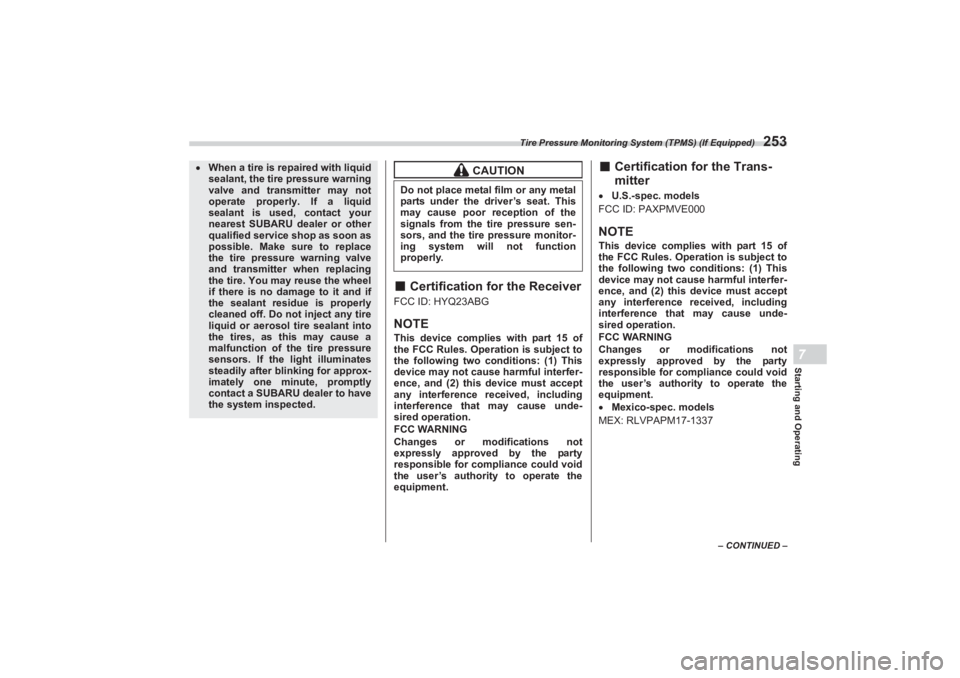
Tire Pressure Monitoring System (TPMS) (If Equipped)
253
Starting and Operating7
– CONTINUED –
■Certification for the ReceiverFCC ID: HYQ23ABGNOTEThis device complies with part 15 of
the FCC Rules. Operation is subject to
the following two conditions: (1) This
device may not cause harmful interfer-
ence, and (2) this device must accept
any interference received, including
interference that may cause unde-
sired operation.
FCC WARNING
Changes or modifications not
expressly approved by the party
responsible for compliance could void
the user’s authority to operate the
equipment.
■ Certification for the Trans -
mitter U.S.-spec. models
FCC ID: PAXPMVE000NOTEThis device complies with part 15 of
the FCC Rules. Operation is subject to
the following two co nditions: (1) This
device may not cause harmful interfer-
ence, and (2) this device must accept
any interference received, including
interference that may cause unde-
sired operation.
FCC WARNING
Changes or modifications not
expressly approved by the party
responsible for compliance could void
the user’s authority to operate the
equipment.
Mexico-spec. models
MEX: RLVPAPM17-1337
When a tire is repaired with liquid
sealant, the tire pressure warning
valve and transmitter may not
operate properly. If a liquid
sealant is used, contact your
nearest SUBARU dealer or other
qualified service shop as soon as
possible. Make sure to replace
the tire pressure warning valve
and transmitter when replacing
the tire. You may reuse the wheel
if there is no damage to it and if
the sealant residue is properly
cleaned off. Do not inject any tire
liquid or aerosol tire sealant into
the tires, as this may cause a
malfunction of the tire pressure
sensors. If the light illuminates
steadily after blinking for approx-
imately one minute, promptly
contact a SUBARU dealer to have
the system inspected.
CAUTION
Do not place metal film or any metal
parts under the driver’s seat. This
may cause poor reception of the
signals from the tire pressure sen-
sors, and the tire pressure monitor-
ing system will not function
properly.
BRZ_U.book 253 ページ 2022年3月29日 火曜日 午後3時59分
Page 260 of 432
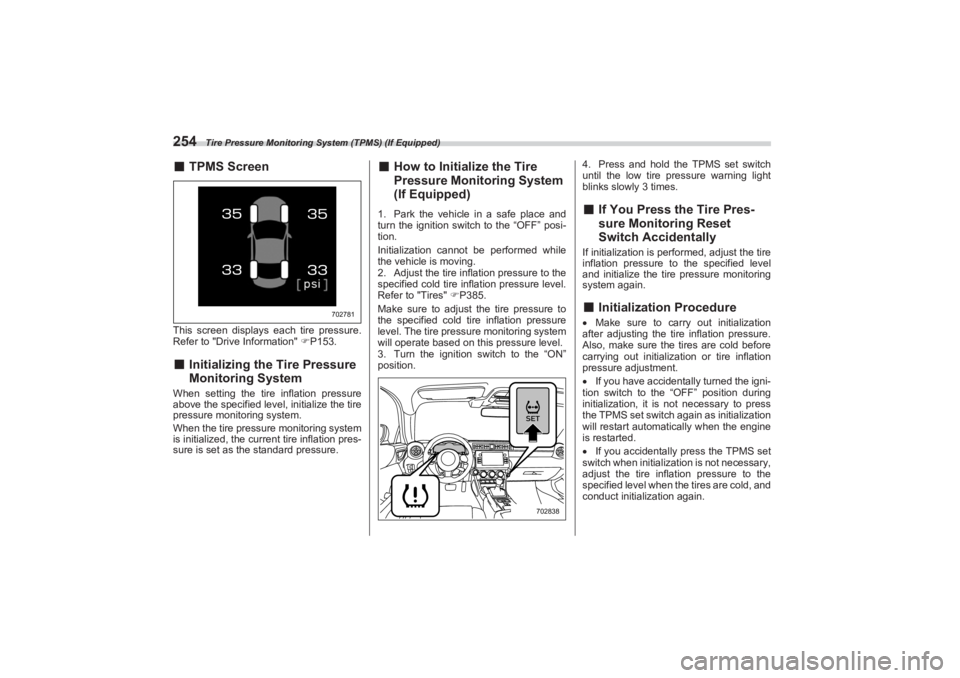
Tire Pressure Monitoring System (TPMS) (If Equipped)
254■TPMS ScreenThis screen displays ea ch tire pressure.
Refer to "Drive Information" P153.■ Initializing the Tire Pressure
Monitoring SystemWhen setting the tire inflation pressure
above the specified level, initialize the tire
pressure monitoring system.
When the tire pressure monitoring system
is initialized, the current tire inflation pres-
sure is set as the standard pressure.
■ How to Initialize the Tire
Pressure Monitoring System
(If Equipped)1. Park the vehicle in a safe place and
turn the ignition switch to the “OFF” posi-
tion.
Initialization cannot be performed while
the vehicle is moving.
2. Adjust the tire infl ation pressure to the
specified cold tire inflation pressure level.
Refer to "Tires" P385.
Make sure to adjust the tire pressure to
the specified cold tire inflation pressure
level. The tire pre ssure monitoring system
will operate based on this pressure level.
3. Turn the ignition switch to the “ON”
position. 4. Press and hold the TPMS set switch
until the low tire pressure warning light
blinks slowly 3 times.
■ If You Press the Tire Pres -
sure Monitoring Reset
Switch AccidentallyIf initialization is perf ormed, adjust the tire
inflation pressure to the specified level
and initialize the tire pressure monitoring
system again.■ Initialization ProcedureMake sure to carry out initialization
after adjusting the tire inflation pressure.
Also, make sure the tires are cold before
carrying out initialization or tire inflation
pressure adjustment.
If you have accidentally turned the igni-
tion switch to the “OFF” position during
initialization, it is not necessary to press
the TPMS set switch again as initialization
will restart automatically when the engine
is restarted.
If you accidentally press the TPMS set
switch when initialization is not necessary,
adjust the tire inflation pressure to the
specified level when the tires are cold, and
conduct initialization again.
702781
702838
BRZ_U.book 254 ページ 2022年3月29日 火曜日 午後3時59分